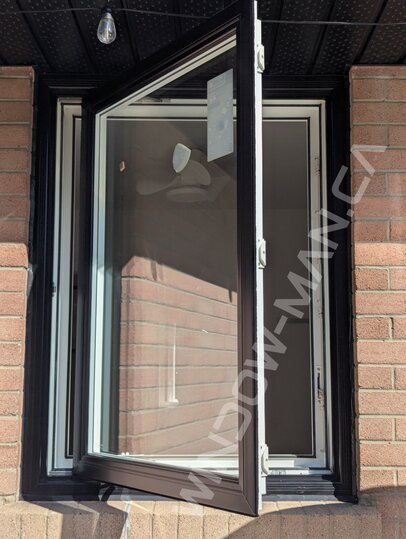
Compare the pros and cons of sliding door vs double door systems from a contractor with 20+ years of experience.
Casement windows are one of the most practical and efficient window styles you can install. They open outward to a full 90° with an easy crank handle — perfect for catching a breeze, directing airflow, and cleaning from inside the house.
When you close a casement window, two rubber tube seals compress — just like a car door gasket — which makes it far more airtight than a sliding or hung window. That means better insulation, less noise, and no cold drafts sneaking in on windy days.
All the windows in my own home are casements. No sliders, no double-hungs — and I’ve never regretted it.
Casement windows combine efficiency, airflow, and simplicity better than almost any other window type.
The only real drawback? You can’t fit a window A/C unit into a casement — but for comfort, airflow, and performance, that’s a fair trade-off.

| Size | Installed price | ||
|---|---|---|---|
| Width | Height | Brick To Brick | Retrofit |
| 16 | 28 | $ 709.28 | $ 567.95 |
| 20 | 30 | $ 729.4 | $ 574.9 |
| 24 | 36 | $ 820.18 | $ 639.34 |
| 24 | 48 | $ 859.68 | $ 652.51 |
| 24 | 60 | $ 951.88 | $ 718.37 |
| 30 | 36 | $ 843.22 | $ 649.22 |
| 30 | 48 | $ 938.71 | $ 718.37 |
| 30 | 60 | $ 1,032.4 | $ 784.23 |
Our casement windows are made from an exclusive 100% lead-free uPVC compound.
It resists impact, fading, blistering, and warping — keeping your windows maintenance-free for decades. The color stays consistent inside and out, and the frames never need painting.
Installation plays a huge role in how well your windows perform and how long they last.
Installation Type |
Description |
Best For / Benefits |
Brick-to-Brick (Recommended) |
Full removal of the old window up to the house framing. Includes options for three brickmould accessory sizes and upgrades to interior trim and jamb. |
Highest efficiency and insulation upgrade. Ideal for replacing damaged or poorly insulated windows. |
Retrofit Installation |
The existing frame and trim remain intact. Only the sash and glazing are replaced, making the process faster and less expensive. |
Great when the current frame is solid and well-insulated. Allows for glazing upgrades without major renovation. |
Stud-to-Stud Installation |
Complete removal down to the house framing. The exterior is finished with caulking or aluminum flashing. |
Similar efficiency boost to brick-to-brick. Perfect for rotted, outdated, or poorly insulated frames. |
Choose between double and triple glazing for your preferred energy performance. Pair that with one of our Low-E coatings to fine-tune comfort and savings:
Every casement window we install uses Super Spacer warm-edge technology, a dual-seal insulating glass system with no metal. It keeps the glass edge warm and dry, reduces condensation, and improves overall energy performance.
Why it matters:
Metal-based spacers can lose up to 50% of a window’s rated R-value — which is why we never use them.
Our vinyl casement windows can be finished to match any interior or exterior style.
Everything is built from the same high-grade PVC compound for color consistency and durability.
Between double or triple glazing, compression seals, and Super Spacer technology, our casement windows are among the most efficient on the market. They keep the heat where you want it, reduce condensation, and help lower energy bills all year round.
A properly installed casement window doesn’t just save energy — it adds real comfort you can feel.
From personal experience, casement windows are the most airtight design you can install.
They hold up against high wind gusts without a whisper of a leak. Once you’ve lived with that kind of performance, it’s hard to go back to sliders or hungs.
If you’re planning a window replacement and want real energy efficiency that lasts, start with casement windows — they’re built to seal, last, and perform.